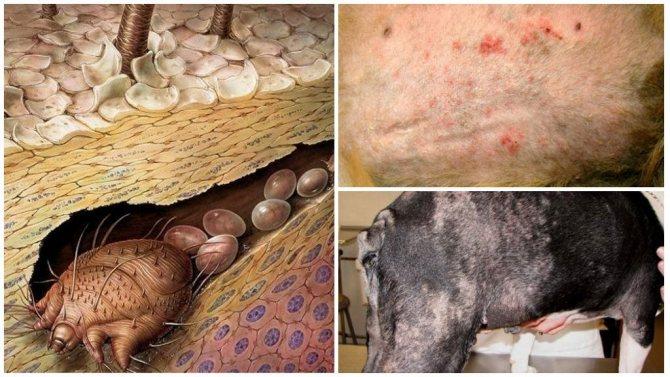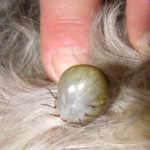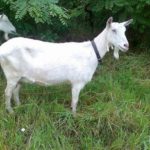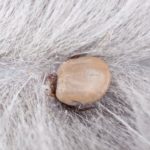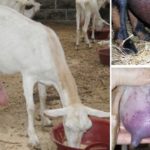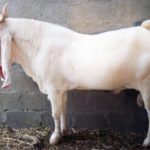The harm caused by ticks to animals is extremely great. Therefore, preventive treatment of all goats against ticks is an important procedure. It is recommended to carry out this activity during pest activity (spring and autumn). But it is necessary to inspect animals regularly after grazing. If it is difficult to get rid of pests, sometimes a drastic remedy is used - trimming the animals.
How dangerous are ticks?
Most often, ticks are located on the lower branches of trees, on bushes or in tall grass.Arthropods attach themselves to sheep imperceptibly and painlessly, since the saliva released at the time of the bite contains anesthetic substances, and the skin loses sensitivity. Ticks are not only carriers of infections, but also pathogens, because they retain viruses in their bodies for several years.
A bite can cause various diseases (borreliosis, psoroptosis, piroplasmosis, tick paralysis, encephalitis, spotted fever). A significant number of ticks on an animal's body can cause anemia. The pest that carries encephalitis is especially dangerous, since consuming unboiled milk increases the risk of infection to people.
Signs and symptoms
A bite can lead to the development of various diseases that have specific symptoms. But the owner, first of all, should be wary of the animal’s apathetic state. The following signs of infection are also observed:
- increased thirst in animals;
- severe itching. In combed areas, hair falls out and areas of the skin are exposed;
- the volume of milk production decreases;
- The goat's body temperature rises to 41 °C;
- approximately two days after the bite, the mucous membrane of the eyes acquires a yellowish tint;
- after three to four days the goats lose a lot of weight, lie down on the bedding and cannot get up on their own;
- after 5-6 days the animal dies.
Infection from tick bites can develop in three forms: acute, chronic, latent. The greatest danger is the acute course of infection: the fur falls off, poor appetite leads to severe exhaustion and death. The chronic form is expressed in moderate itching.
If treatment is not started in time, then after a few months the infection becomes acute. In the latent form, there is slight itching and mild symptoms of the disease.
What to do if a goat is bitten by a tick?
After animals return from pasture, they must be carefully examined. Due to the thick fur, it is sometimes difficult to see ticks on the body of animals. Therefore, it is advisable to feel your pets, since when a bite occurs, swellings with a diameter of 0.7-1.5 cm form on the skin. If a bite is detected, the area of skin is wiped with alcohol. It is recommended to remove the pest in several steps:
- make a loose loop from cotton thread;
- carefully grasp the tick body with a loop;
- to completely pull out the pest, make loose movements with the thread - left and right;
- the bite site is treated with disinfectants.
Important! When using tweezers, do not put pressure on the tick; carefully grab it and pull it out with a twisting motion.
When removing pests, it is not recommended to use fatty creams or oil products. If clinical symptoms appear, you should contact your veterinarian. Naturally, it is easier to prevent bites than to treat animals for diseases. Therefore, in order to protect pets, all kinds of prevention are carried out.
Preventive actions
The most optimal measure to reduce the likelihood of tick attacks on animals is clearing and improving grazing areas. They remove dried leaves, mow overgrown grass, and clear debris from dry branches. If there are doubts about the purity of the pasture, the perimeter around the site can be treated with organophosphorus preparations and synthetic pyrethroids (carried out by the relevant organizations). It is also necessary to spray the areas where animals are kept with a creolin solution. During the period of active tick reproduction, it is advisable to bathe goats more often.
To protect their pets from bites, experienced farmers treat animals with a 10% Tsiperil solution before grazing. The fur of adult individuals is soaked with a foam sponge and left to dry. It is easier to bathe goats older than two weeks in the solution (you need to protect your mouth and nose from getting liquid). Also used for treatment is the drug “Ectolipar”, the effect of which lasts for up to three months (after treatment, milk should not be consumed for three days).
Can I drink milk from an affected goat?
Humans become infected with encephalitis by consuming raw milk from an affected animal. Sick goats experience loss of appetite, lethargy, and paralysis of the hind limbs. Milk that is milked takes on a reddish tint. After settling, a reddish, slimy-looking sediment forms at the bottom of the container.
It should be taken into account that the virus persists in milk for 8-9 days after infection. Therefore, for preventive purposes, it is recommended to consume milk only after boiling. The causative agent of the disease is destroyed in milk at a temperature of 60-65 ° C in 20 minutes. To completely destroy the virus, the liquid is boiled for 2-2.5 minutes.
The main thing is not to panic when you find a tick on your pet’s body. You should try to remove the pest yourself. In difficult cases or when symptoms of infection appear, immediately contact a veterinarian. To prevent infection, they practice regular inspection of pets after grazing and treating animals with acaricidal agents.

